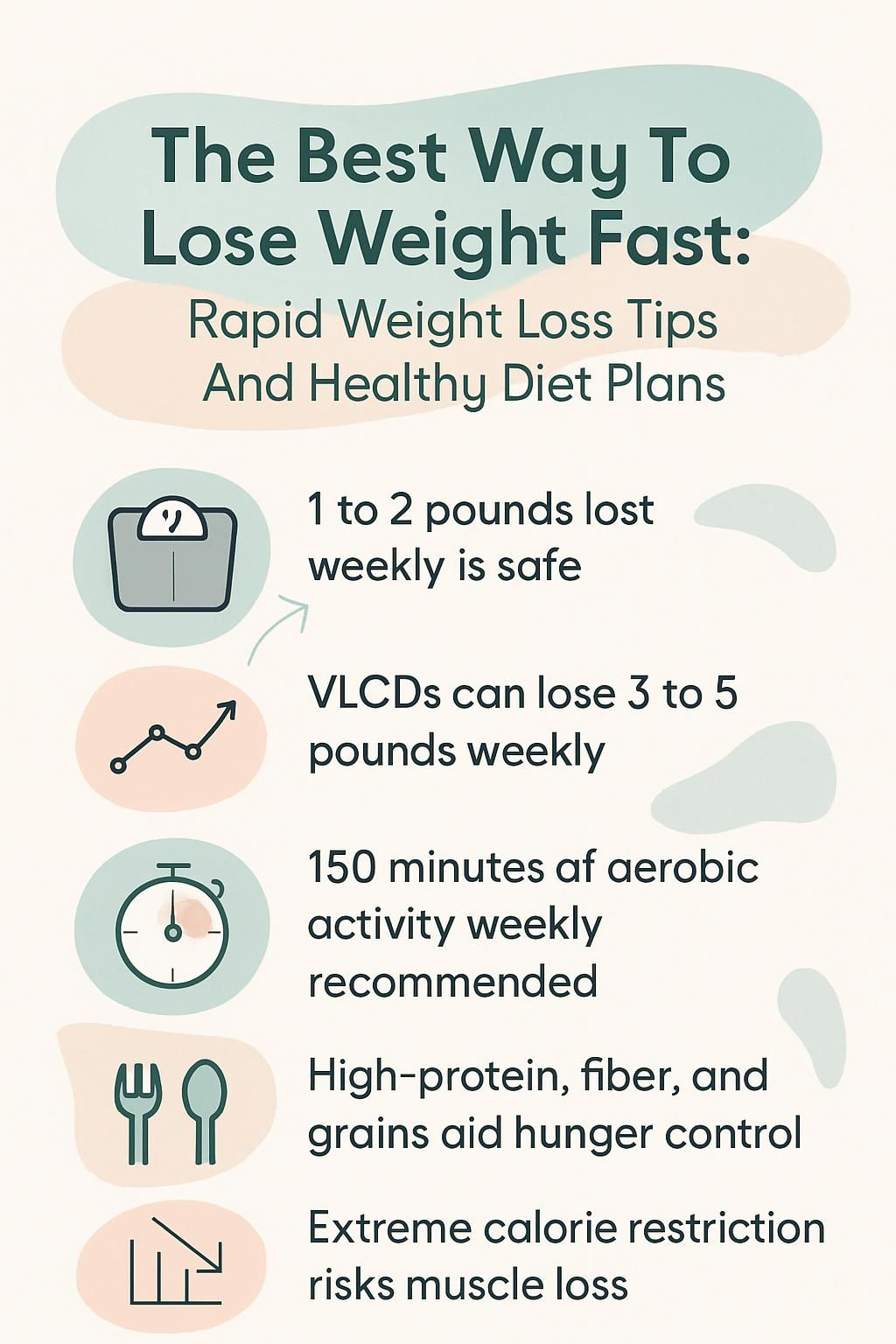The Best Way To Lose Weight Fast: Rapid Weight Loss Tips And Healthy Diet Plans
Our Nutrition Assistant AI Suite will transform your body. You will lose fat, get toned, and build muscle. Gain confidence and optimal health.
If you want to lose weight quickly and safely, you are in good company. Many people want quick results but face mixed messages and risky plans. This guide cuts through the noise with science-based weight loss tips and healthy diet plans.
You will learn how to set smart goals, choose nutrient-dense foods like whole grains and vegetables, and use safe methods that speed progress. The aim is fast results without harming your health. Start here for clear steps you can follow today.
Key Takeaways
- Safe progress is 1 to 2 pounds per week, a rate supported by major health groups.
- Very low-calorie diets at about 800 calories can drop 3 to 5 pounds weekly, but only with medical care.
- Pairing protein, fiber-rich vegetables, and whole grains helps control hunger and protects muscle.
- Aim for 150 minutes of aerobic activity each week plus strength training twice weekly to support fat loss.
- Extreme restriction and fad diets raise risks like muscle loss, gallstones, and quick regain after stopping.

Understanding Rapid Weight Loss

Fast results can feel exciting. They also come with rules that keep you safe.
What is rapid weight loss?
Rapid weight loss means dropping more than 2 pounds, about 1 kilogram, per week for several weeks. Doctors may suggest this if you have obesity and face urgent health risks, for example before surgery or to improve type 2 diabetes.
Very low-calorie diets, called VLCDs, can lead to losses of 3 to 5 pounds per week. These plans usually use meal replacements and strict calorie targets. They must be supervised by a healthcare professional due to risks like nutrient gaps and gallstones.
These methods are short term. They can help you start strong, but they are not meant for months at a time. A safer long path includes a balanced diet, steady activity, and check-ins with your care team.
Talk with your healthcare provider before starting any rapid approach. Medical guidance helps you lose weight safely.
What are common myths and facts about fast weight loss?
Myth: Fast loss always leads to long-term success. Fact: Most people regain weight after extreme plans end. Habits matter more than speed.
Myth: Anyone can safely follow extreme calorie cuts. Fact: VLCDs need medical oversight to prevent side effects and monitor labs.
Myth: Exercise is not needed if you eat very little. Fact: Movement helps maintain muscle and keeps your metabolism from slowing too much.
Short bursts of fast loss can improve blood sugar, blood pressure, and cholesterol under medical care. Still, they work best as part of a healthy lifestyle with regular physical activity and a balanced eating pattern.
Setting and Tracking Weight Loss Goals
Clear targets help you act with focus. Tracking turns small wins into steady momentum.
How do I set realistic weight loss targets?
Set a pace of 1 to 2 pounds per week. This rate is linked to better long-term weight management. Many people start with a first goal of losing about 5 percent of their starting weight.
For example, if you weigh 180 pounds, target 9 pounds first. Create a daily deficit of 500 to 750 calories through diet, movement, or both. Choose a timeline that fits your life so your plan is doable. Ask your healthcare provider if weight-loss medicines or extra support could help alongside healthy eating and exercise.
What are effective ways to monitor my weight loss progress?
Use a simple journal or a free NHS weight loss plan app to track food and activity. Writing down what you eat improves portion control and calorie awareness. It also shows patterns, such as late-night snacking or skipped meals.
Weigh in once a week under similar conditions. Add waist or hip measurements every two to four weeks. Many people find that tracking reveals links among sleep, stress, and hunger. Digital tools also make it easier to spot meals high in protein and dietary fiber, which can help you feel full longer.
Diet Plans That Speed Up Weight Loss
Good plans create a calorie deficit and tame hunger. The best ones are clear, structured, and safe.
What is a Very Low-Calorie Diet (VLCD)?
A Very Low-Calorie Diet limits intake to about 800 calories per day. Doctors use VLCDs for adults with obesity who need rapid progress, for example before bariatric surgery or heart treatment.
Most VLCDs rely on meal replacement shakes, soups, or bars that pack needed vitamins and minerals at very low calories. Many people lose 3 to 5 pounds per week on these plans. Medical supervision is required to watch for issues like gallstones, gout, fatigue, and constipation. VLCDs are usually limited to 12 weeks or less.
If you want a more flexible option, consider a Low-Calorie Diet for longer use.
How does a Low-Calorie Diet (LCD) work?
Low-Calorie Diets typically provide 1,200 to 1,500 calories per day for women and 1,500 to 1,800 for men. They often mix meal replacements with regular foods such as fruits, vegetables, lean proteins, and whole grains.
Loss may be slower than with VLCDs, but results can match over time. Many people find LCDs easier to follow because they feel less restricted. High-fiber choices, like bran cereal at breakfast, help you feel full on fewer calories. Groups like the American Heart Association support balanced plans that limit hunger hormones like ghrelin and improve heart health.
What is time-restricted eating and how does it help?
Time-restricted eating sets a daily eating window. One common pattern is 16:8, which means you eat for eight hours and fast for sixteen. A 12:12 pattern is a gentler start.
Shortening your eating window often lowers total calories without counting every bite. Studies suggest it may improve appetite control and reduce late-night snacking. Many people feel fewer cravings once blood sugar is steadier. Pair this schedule with nutritious foods, such as protein-rich meals, instead of refined carbs like white bread or pasta.
What are the benefits of intermittent fasting?
Intermittent fasting includes plans like the 5:2 schedule, where you eat normally five days per week and restrict two days. Some people find it easier than continuous calorie counting because the rules are simple.
Research shows benefits like fat loss around the waist, better insulin levels, and a lower risk of heart problems. You may find it easier to trim calories without feeling deprived every day. A plant-forward pattern with intermittent fasting can support digestion and hunger hormones like leptin and cholecystokinin.
Long-term data is still building. Pick a method that fits your routine, not the other way around.
Best Foods to Eat for Rapid Weight Loss
The right foods help you feel full, protect muscle, and support steady fat loss.
Why are protein-rich foods important for weight loss?
Protein helps maintain muscle while you lose fat. Keeping muscle supports your metabolism, which is how your body burns calories at rest. High-protein meals also increase fullness so you snack less.
Good options include chicken breast, Greek yogurt, eggs, tofu, and fish. Add a protein source to every meal. This simple change can lower cravings for refined snacks and make a low-calorie plan easier to follow over time.
How do high-fiber foods support weight loss?
Fiber slows digestion, which helps you feel full longer. It also supports gut health, the community of bacteria that help you digest food. Fruits, vegetables, beans, and whole grains are top choices.
Aim for at least 4 servings of vegetables and 3 servings of fruit each day. Swapping white rice for brown rice, or choosing oats and barley, boosts fiber and may improve digestion. Many people find that starting meals with a salad or adding lentils reduces between-meal snacking.
Why should I avoid sugar and refined carbs?
Added sugar and refined starches cause quick blood sugar spikes, then a crash. The crash triggers hunger and cravings, which can lead to overeating. Cutting sugary drinks is a fast win for many people.
High intakes of sweetened drinks and processed foods raise the risk of prediabetes and heart disease. Reducing them helps you create a calorie deficit without constant hunger. Diets lower in refined carbs support steadier energy and fewer cravings, which helps prevent weight cycling.
How do healthy fats and whole grains aid weight loss?
Healthy fats, like olive oil, avocado, and nuts, improve fullness. Small portions can curb hunger between meals. Replacing saturated fats with unsaturated fats helps heart health during weight loss.
Whole grains such as brown rice, whole-wheat bread, and quinoa offer more nutrients and fiber than refined grains. They digest more slowly and support stable blood sugar. People who eat more whole grains tend to lose more body fat than those who rely on refined carbs.
These swaps reduce cravings while keeping meals satisfying.
Foods to Avoid for Successful Weight Loss
Some foods make hunger stronger and progress slower. Skipping them simplifies your plan.
Which processed and sugary foods should I avoid?
Limit soda, candy, sweetened juices, and energy drinks. Packaged snacks, desserts, cookies, pastries, and many breakfast cereals contain added sugars and unhealthy fats. They add a lot of calories with little fiber.
Frozen dinners and flavored yogurts can hide large amounts of sugar. A single flavored yogurt can match a candy bar in sugar. Swap candy bars for a handful of nuts or fresh fruit. You will get steady energy without the sugar swings.
Why cut out refined grains and trans fats?
Refined grains like white bread or many crackers digest fast and leave you hungry sooner. This leads to higher calorie intake later. Trans fats, often found in processed snacks and some fried foods, raise bad cholesterol and harm heart health.
Removing refined grains and trans fats improves blood sugar control, inflammation, and energy. A simple swap, like whole-grain oats for white toast, can keep you full longer and support steady loss without feeling deprived.
Exercise Strategies for Faster Weight Loss
Movement speeds fat loss and protects your metabolism. Think of it as your plan’s engine.
What are the benefits of aerobic exercise for weight loss?
Aerobic activity burns calories and improves heart health. Brisk walking, cycling, and swimming are great options. Aim for at least 150 minutes each week, which can be 30 minutes on most days.
Cardio helps reduce body fat while protecting muscle when paired with protein-rich meals. Many people find that a 10 to 15 minute walk after meals improves digestion and leads to steadier progress. Pairing daily movement with healthy eating keeps motivation high.
How does strength training help burn fat?
Strength training preserves and builds muscle. Muscle tissue raises your basal metabolic rate, which means you burn more calories even at rest. Train at least twice per week.
Use bodyweight moves like squats and push-ups, resistance bands, dumbbells, or machines. Strength work helps prevent the metabolic slowdown that can happen during calorie restriction. People often feel stronger and look leaner as body composition changes.
How can I add more daily physical activity?
Small changes all day long add up. These moves increase calorie burn without a gym session.
- Take the stairs whenever you can to raise your daily step count.
- Park farther from entrances and walk those extra steps.
- Stand during calls or meetings to cut sitting time.
- March in place for a few minutes each hour, especially if you sit a lot.
- Wear comfortable shoes so quick walks feel easy and inviting.
- Schedule movement on your calendar to build consistency.
- Track steps with a pedometer or phone app to hit daily targets.
- Take short active breaks after meals to support blood sugar control.
- Turn chores into mini workouts with brisk cleaning or yard work.
[*Source: Systematic review and meta-analysis on pedometer-based programs, JAMA 2007]
These simple habits can lead to steady loss. Many people report dropping several pounds in a few months with routine tweaks alone.
Lifestyle Changes to Improve Weight Loss Results
How you sleep, manage stress, and hydrate affects appetite and energy. Simple routines make a big difference.
How can I manage stress to lose weight better?
High stress often triggers emotional eating and quick food choices. List your common stress triggers, then plan a response, such as a walk, a short stretch, or a call with a supportive friend.
Exercise lowers cortisol, a stress hormone that can raise cravings. Relaxation techniques like deep breathing and meditation improve mood and diet choices. Choose self-care activities, like reading or a calm outdoor walk, to replace stress snacking.
What are ways to improve sleep quality for weight loss?
Keep a consistent sleep and wake time, even on weekends. That helps regulate hunger and fullness hormones. People who sleep well have fewer cravings and make better food choices during the day.
Limit screens before bed because blue light disrupts sleep. Create a quiet routine with reading or gentle stretches. Aim for 7 to 9 hours nightly. Short sleep increases cravings for sugary foods and makes overeating more likely.
Simple changes, like charging your phone outside the bedroom, can reduce late-night snacking and support morning energy.
Why is staying hydrated important for weight loss?
Water before meals can reduce how much you eat. Hydration supports digestion and helps your body burn calories more efficiently. It also assists your body in processing nutrients and removing waste.
Swap high-calorie drinks for water or unsweetened tea. Proper hydration helps workouts feel easier and reduces fatigue. That makes it more likely you will stick with routine activity.
Advanced Techniques to Boost Weight Loss
Use these evidence-based tools to fine-tune your plan. Think of them as small levers with big impact.
How does mindful eating improve weight loss?
Mindful eating means paying attention to true hunger and fullness signals. It helps cut overeating driven by emotions or habit. Research shows mindful eaters often lose more weight and keep it off longer.
Eat without distractions. Slow down and notice flavors and textures. Stopping when you feel comfortably full can reduce daily calories without strict rules.
What are tips for managing calories and portion sizes?
Use 9-inch plates or smaller to limit portions. Eat slowly so your brain can register fullness before you refill your plate. Pre-portion snacks into small bowls or bags.
Split restaurant entrees or box half your meal first. Track intake with an app or notebook. Studies show these steps lower daily calories and improve long-term weight maintenance.
How does balancing gut bacteria aid digestion and weight loss?
Feeding healthy gut bacteria can improve digestion and may support weight control. Prebiotics are fibers that feed good bacteria. Common sources include beans, oats, bananas, onions, and asparagus.
People with a more diverse gut microbiota often have easier weight control. Processed foods and added sugars can harm this balance. Shifting to more whole grains, vegetables, and legumes supports a healthier gut and steadier energy.
Common Mistakes to Avoid in Rapid Weight Loss
Steer clear of traps that slow progress or harm health. A few fixes can save weeks of frustration.
What are the dangers of over-restricting calories?
Extreme restriction raises the risk of muscle, water, and bone loss. Side effects can include gallstones, gout, fatigue, constipation, diarrhea, and nausea. Metabolism may slow to conserve energy, which stalls progress.
Going too low without medical oversight is unsafe. Your body needs enough nutrients to protect organs and digestion. Keep intake balanced to lose weight safely and maintain results.
Why is skipping meals risky for weight loss?
Skipping meals often leads to overeating later. Hunger builds and pushes you toward bigger portions and high-calorie foods. Irregular eating can also slow your metabolism.
Stick to a consistent meal schedule. Plan a protein-rich breakfast or a balanced first meal to prevent mid-morning cravings. Many people find this one habit anchors the rest of the day.
How can fad diets harm your weight loss journey?
Fad diets usually push extreme rules and deep cuts. Many people lose quickly, then regain within months. Cutting whole food groups can also cause nutrient gaps and low energy.
These plans can slow your metabolism, create headaches and fatigue, and make workouts harder. Sustainable habits, not short-term tricks, give better results.
Health Risks of Extreme Weight Loss
Rapid loss without safeguards can backfire. Your goal is fast progress with safety in mind.
What potential health risks come with extreme weight loss?
Losing weight too fast can reduce muscle, water, and bone instead of only fat. Risks include gallstones and gout. Many people report fatigue, dizziness, constipation, or nausea when they push too hard.
Quick regain is common after harsh diets end, which strains the body. If you are considering extreme steps, do so only under medical supervision. A steady, structured plan is safer for most people.
Why is a sustainable weight loss approach better?
Slow and steady methods are easier to maintain and less likely to cause regain. Health agencies advise 1 to 2 pounds per week for most adults. This pace protects muscle and supports healthier habits.
Building skills around meal planning, portion sizes, and daily movement makes long-term maintenance more likely. Gradual change sets you up for lasting success.
Benefits of Properly Managed Rapid Weight Loss
Done with care, rapid loss can lift energy, mood, and health markers in a short time.
How does rapid weight loss increase energy levels?
As you drop extra pounds, your body carries less load. Daily tasks feel easier and less tiring. Many people notice more energy within the first few weeks.
Better sleep often follows weight loss. Quality rest improves focus and reduces daytime fatigue. Less pressure on joints can make movement more comfortable, which encourages even more activity.
What general health improvements can I expect?
Weight loss can improve blood sugar control and reduce the need for some diabetes medicines. Blood pressure and cholesterol levels often improve as well.
Lower weight supports heart health and mobility. Walking becomes easier, and joint pain often lessens. These wins help you stay active and keep progress going.
How does weight loss boost confidence and motivation?
Hitting milestones builds confidence. Seeing progress on the scale or in photos reinforces your efforts. Positive feedback from friends and family can also keep you going.
Track small wins, like fitting into old clothes or walking farther without getting winded. These markers help you stay engaged with your plan.
Frequently Asked Questions About Rapid Weight Loss
Here are direct answers to common questions so you can move forward with clarity.
Is rapid weight loss safe?
Rapid plans can be safe when supervised by a healthcare professional. Doctors sometimes use VLCDs before surgery or to address urgent health risks. Children, teens, people who are pregnant, and older adults should avoid extreme plans unless a clinician directs otherwise.
Work with your provider if you choose a rapid approach. Regular check-ins and lab tests help prevent nutrition problems and manage side effects.
How much weight can I realistically lose per week?
Most people can safely lose 1 to 2 pounds per week with a healthy diet and regular physical activity. Faster loss may raise risks and is harder to maintain without medical care.
Under strict supervision, VLCDs can produce 3 to 5 pounds per week for short periods. Track progress weekly and adjust goals to match safe practices.
Conclusion
Fast results are possible with a smart plan, clear goals, and healthy habits. Use structured diet plans, balanced meals, and regular physical activity to reach your targets. Set a safe pace, track your progress, and keep your focus on skills you can live with.
Research shows that people who monitor progress, set realistic goals, and stay active maintain more weight loss over time [1][2]. Choose the approach that fits your life, then work it consistently. For medical conditions or very low-calorie plans, involve your healthcare provider for safety.
References:
[1] Wing RR, Phelan S. “Long-term weight loss maintenance.” Am J Clin Nutr 2005;82(1 Suppl):222S-225S.
[2] Jakicic JM et al. “Physical Activity Considerations for Rapid Weight Loss.” Med Sci Sports Exerc 2018;50(10):1983–1990.
FAQs
1. What is the best way to lose weight fast while staying healthy?
Rapid weight loss works best with a balanced eating plan, regular physical activity, and careful portion control. Studies show that combining lean proteins, whole grains, fruits, and vegetables helps reduce calorie intake without losing key nutrients. A review in The American Journal of Clinical Nutrition found that people who followed structured meal plans lost more body fat than those who did not.
2. Are rapid weight loss tips safe for everyone?
Not all rapid weight loss methods are safe for every person. Health experts recommend consulting a licensed healthcare provider before starting any new diet or exercise routine, especially if you have medical conditions such as diabetes or heart disease. Evidence suggests that slow and steady progress often leads to better long-term results.
3. How can I create an effective healthy diet plan for quick results?
A successful eating strategy includes setting realistic goals and tracking your food choices daily. Use lists of low-calorie foods like leafy greens, berries, fish fillets, beans, and yogurt cups to build meals rich in fiber and protein but low in sugar and saturated fats. For example, after switching from fried snacks to fresh fruit bowls during my lunch break last year, I noticed improved energy levels within weeks.
4. What role does exercise play in rapid weight loss programs?
Physical activity increases calorie burn which supports faster fat reduction when paired with proper nutrition plans. Research published by the Centers for Disease Control shows adults who walk briskly at least 150 minutes per week see greater improvements in both body composition and overall health compared to those relying on dietary changes alone.
Summary: Rapid fat reduction depends on smart food choices combined with consistent movement routines; always check with a professional before making major lifestyle adjustments.







